Social Commerce: Turning Likes into Sales on Social Media Platforms
Did you know that, as per Sprout Social, more than 68% of consumers have already purchased directly from social media and nearly all consumers plan to make at least one purchase through social shopping or influencer commerce this year?
It’s not just scrolling anymore; it’s shopping on the same platform where you follow your favorite influencers and share memes.
Now, let’s ask a question: Have you ever wondered how that trendy dress your friend posted ended up in your closet with just a few taps?
That’s the magic of social commerce, and we’re about to dive into the excitement.
In this article, we’re going to unravel the world of Social Commerce. So, let’s get started.
1. The Rise of Social Commerce:
Picture this: you’re scrolling through your favorite social media platform, double-tapping on cute pet videos and stunning travel photos.
But here’s the plot twist – what if those taps could lead you to your next fashion find or tech gadget?
Welcome to the world of social commerce, where likes aren’t just gestures; they’re turning into sales.
1.1. The Growth Spurt:
In recent years, social commerce has been on a rocket-like trajectory.
As per Hubspot, the number of people shopping directly through social media has increased by 10.5 % in the last year alone.
It’s not just a trend; it’s a shopping revolution happening in the palm of your hand.
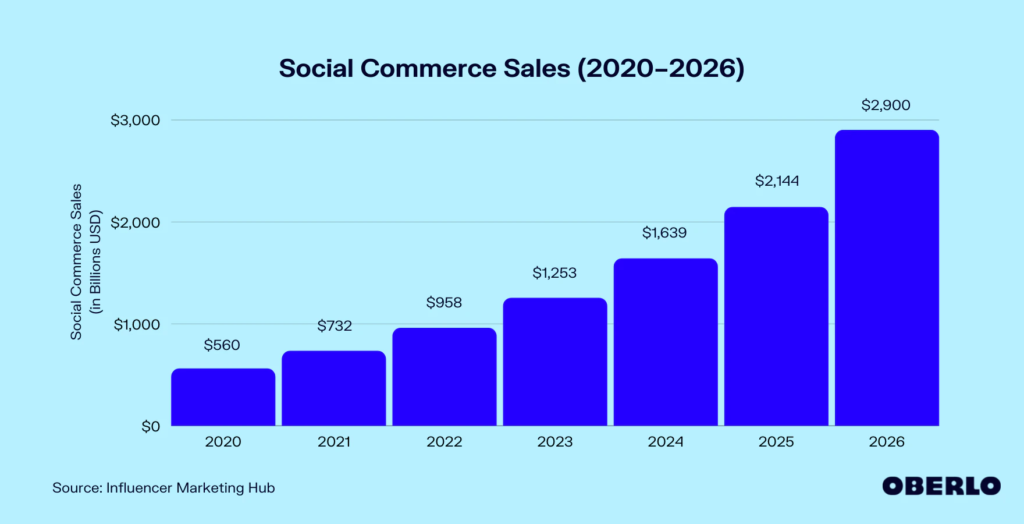
1.2. Social Media: The New Marketplace:
Social media platforms have transformed from mere social hangouts to bustling marketplaces.
From Facebook to Instagram, users are not just sharing experiences; they’re sharing their favorite products, and savvy businesses are capitalizing on this shift.
1.3. Changing the Shopping Game:
Social commerce isn’t just changing where we shop; it’s altering the entire shopping game.
Consumers are not just buyers; they’re active participants in the discovery and recommendation process.
The days of clicking away to another site to shop are fading, making way for seamless transactions right where you scroll.
Learn a few quick tips to improve your social media strategy with us.
So, why the buzz? How did social commerce go from a quirky idea to a shopping powerhouse?
Buckle up as we explore the growth and significance of social commerce, backed by numbers that paint a picture of a new era in online shopping.
2. Understanding Social Commerce:
Alright, let’s break down the buzzword – social commerce.
It’s not just a fancy term; it’s a game-changer in the way we buy and sell online.
So, what exactly is social commerce, and how does it shake hands with traditional e-commerce?
2.1. Social Commerce Unveiled:
At its core, social commerce is like the cool fusion of social media and online shopping.
It’s where your favorite platforms become not just a hangout spot but also your go-to shopping destination.
In simple terms, it’s turning those casual scrolls into a virtual shopping spree.
2.2. Different from Traditional E-Commerce:
Now, let’s distinguish it from its cousin, traditional e-commerce.
Traditional e-commerce is like a standalone store; you visit the website, browse the products, and make a purchase.
Social commerce, on the other hand, flips the script. It brings the store experience to where you’re already hanging out – social media.
No need to hop between tabs; the shop is right there on your feed.
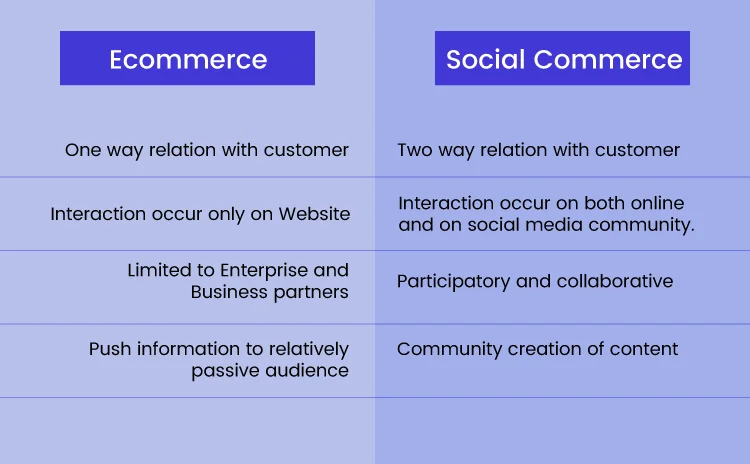
2.3. Social Media Platforms as Shopping Hubs:
How does this magic happen?
Social media platforms are not just about likes and shares anymore; they’re becoming full-fledged shopping hubs. Imagine tapping on a post and finding a “Shop Now” button.
It’s that easy.
Platforms like Instagram and Facebook are integrating shopping features seamlessly, allowing you to explore, choose, and buy without leaving the app.
2.4. From Discovery to Checkout:
Social commerce isn’t just about selling; it’s about creating a journey.
You discover a product through a post, explore more details on the same platform, and with a few clicks, it’s yours.
The integration of shopping features ensures that your entire shopping experience, from discovery to checkout, happens right where you are already spending your time.
In essence, social commerce is making shopping as simple as a tap, and it’s changing the way we interact with our favorite brands.
3. The Power of Social Media Influence:
Ever found yourself buying something just because your favorite influencer showcased it on your feed?
That’s the magic of social media influence, and it’s not just a trend; it’s a powerful force shaping the world of social commerce.
3.1. Influence in Every Scroll:
Social media influencers are not just content creators; they are trendsetters and trusted voices in the digital space.
As per recent studies, a significant number of users admit that they’ve made purchasing decisions based on influencer recommendations.
It’s like having a friend’s opinion on the things you’re considering buying.
3.2. The Trust Factor:
Why do influencers hold such sway?
The answer is simple: Trust.
The relationship between influencers and their followers is built on authenticity and relatability.
When an influencer vouches for a product, it feels more like a recommendation from a friend than a traditional ad.
This trust factor is a game-changer in the world of social commerce.
3.3. Leveraging Influencer Marketing:
Businesses are quick to catch on to the influence game. Influencer marketing is not just a buzzword; it’s a strategic move to tap into the power of social media personalities.
By collaborating with influencers, businesses can organically showcase their products in a way that resonates with the audience.

3.4. Humanizing Brands:
In the world of e-commerce, where transactions often feel transactional, influencers bring a human touch.
They use products, share experiences, and make the brand more relatable.
Businesses, by leveraging influencer marketing, can bridge the gap between a product and its potential buyer, making it more than just an item on a shelf.
3.5. Metrics of Influence:
Measuring the impact of influencers goes beyond likes and comments.
Smart businesses are using data to understand the real impact on sales.
So, how do influencers turn a casual scroll into a shopping spree?
How can businesses harness this power to boost their social commerce game?
Influencers have the unique ability to transform a casual scroll into a shopping spree by cultivating authenticity and engaging storytelling.
Businesses can harness this power by strategically partnering with influencers whose values align with their brand.
By building long-term relationships with influencers and consistently evaluating the impact on sales, businesses can elevate their social commerce game, turning influencer-driven engagement into tangible and sustainable conversions.
4. Optimizing Your Social Media Profiles for Commerce:
Now, let’s talk about turning those likes and follows into actual sales. It’s time to optimize your social media profiles for commerce and create a shopping experience that keeps your audience coming back for more.
4.1. Crafting a Shopper-Friendly Bio:
Your bio is like the storefront window of your social media profile.
Make it clear, concise, and inviting. Let people know what you offer, and don’t forget to include a link that directs them to your online store.
First impressions matter, even in the digital world.
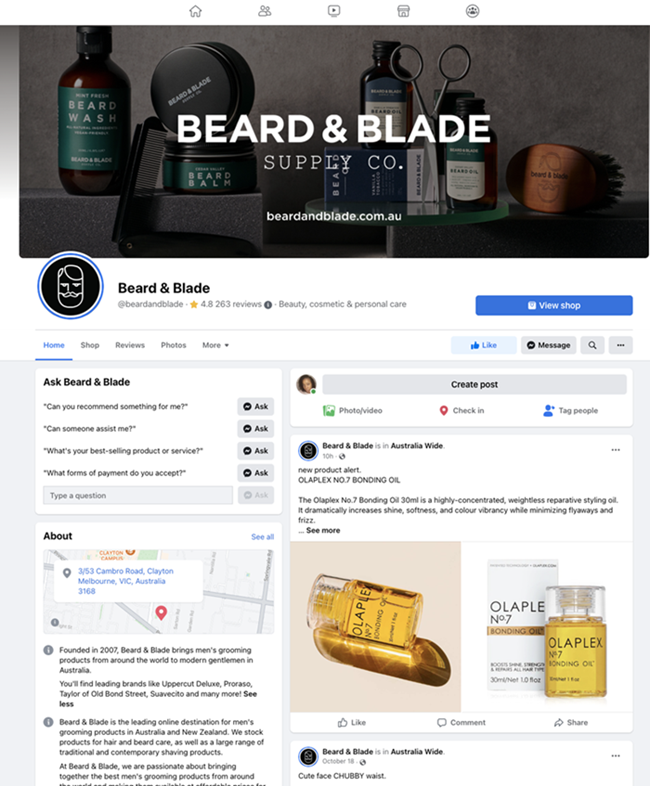
4.2. Shoppable Posts:
Take advantage of shoppable posts to transform your feed into a virtual shopping aisle.
Platforms like Instagram and Facebook allow you to tag products directly in your posts, making it easy for users to explore and purchase with just a few taps.
4.3. Tell a Visual Story:
Engaging visuals is the key to capturing attention. Use high-quality images and videos to showcase your products in action.
Create a visual story that speaks to your brand and resonates with your audience.
A HubSpot study shows that video is the most popular and effective media format.
Here are some tips to help you improve your blog visuals.
4.4. User-Generated Content:
Encourage your customers to share their experiences with your products.
User-generated content not only adds authenticity but also turns your customers into brand ambassadors.
Share this content on your profile to build a sense of community and trust.
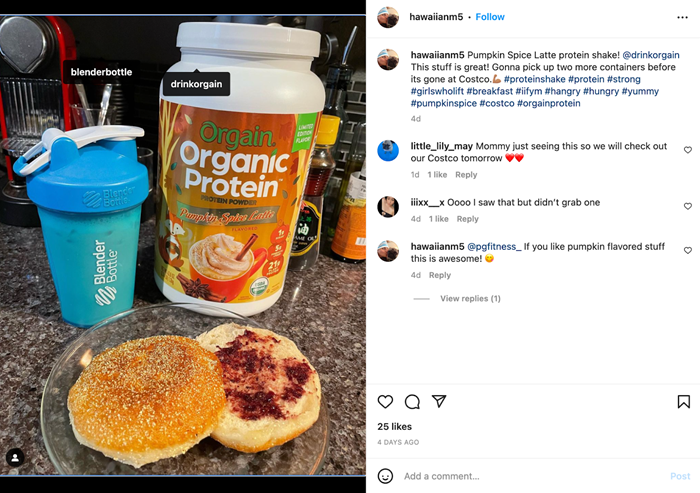
4.5. Promotions and Exclusive Offers:
Everyone loves a good deal.
Use your social media platforms to promote exclusive offers, discounts, and limited-time deals. Create a sense of urgency to drive conversions.
4.6. Engage and Respond Promptly:
Social media is not just a broadcasting platform; it’s a two-way street.
Engage with your audience by responding to comments and messages promptly.
Personalized interactions build a connection and boost customer confidence.
4.7. Customer Reviews and Testimonials:
Feature positive reviews and testimonials prominently on your social media profiles.
Real-life experiences from satisfied customers act as powerful endorsements.
4.8. Utilize Instagram Stories and Reels:
Leverage the ephemeral nature of Instagram Stories and Reels to create a sense of immediacy.
Showcase behind-the-scenes glimpses, product demonstrations, and sneak peeks.
These temporary yet engaging formats can drive engagement and conversions.
4.9. Metrics and Analytics:
Don’t forget to measure the impact of your efforts.
Utilize analytics tools provided by social media platforms to track the performance of your commerce-related activities. Insights into what works and what doesn’t will help refine your strategy.
By optimizing your social media profiles for commerce, you’re not just selling products; you’re creating an immersive shopping experience.
5. Creating a Seamless Shopping Experience:
Ever had a shopping experience that felt as smooth as silk, from the moment you discovered a product to the joy of clicking “purchase”?
That’s the magic of a seamless shopping experience, and businesses are tuning in to make it a reality on your favorite social media platforms.
5.1. From Discovery to Delight:
The journey begins with discovery – that delightful moment when you spot something intriguing on your feed.
A seamless shopping experience ensures this discovery smoothly transforms into a desire to explore more.
The process is designed to be intuitive, so you effortlessly move from one step to the next.
5.2. Shoppable Posts:
Imagine tapping on an image of your favorite product and finding yourself on a mini shopping spree without leaving the app.
Shoppable posts turn your feed into a virtual storefront.
They’re not just posts; they’re opportunities.
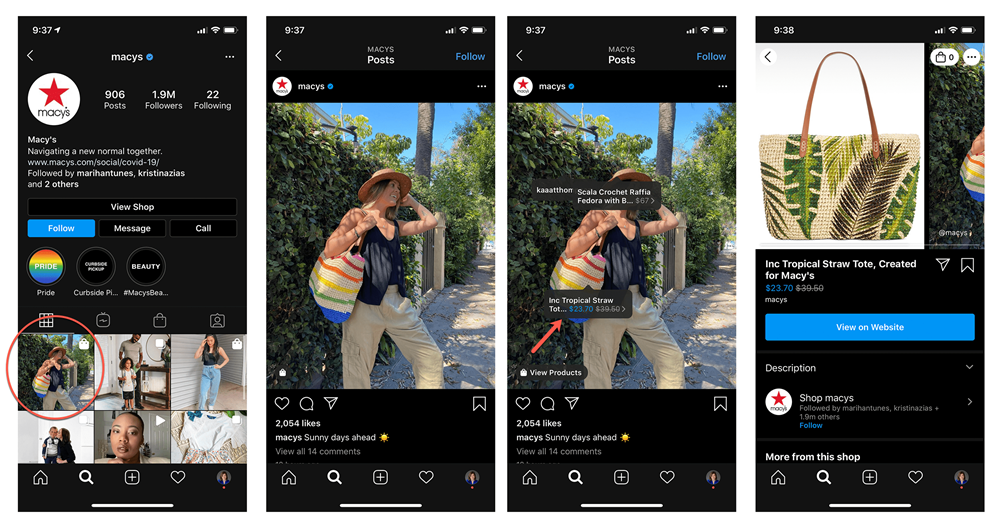
5.3. In-App Shopping:
Why leave the comfort of your social media haven to make a purchase?
In-app shopping features allow you to browse, select, and buy without switching tabs.
It’s like having a boutique right at your fingertips. Businesses are embracing this feature, and benefitting from it.
5.4. Smooth Checkouts:
Ever abandoned a cart because the checkout process felt like solving a puzzle?
A seamless shopping experience ensures checkouts are as smooth as a breeze.
Minimal clicks, clear instructions, and secure transactions make the final step just as enjoyable as the first.
5.5. Personalized Recommendations:
The journey doesn’t end with a single purchase.
Businesses are using data to offer personalized recommendations, turning your post-purchase experience into a continued adventure.
This not only keeps customers engaged but also boosts loyalty.
5.6. Integration of Social Proof:
Imagine seeing that others have loved a product before you.
Social proof, like customer reviews and user-generated content, adds authenticity to the shopping experience.
The Impact of Social Media on Blog Engagement – Blogillion product; it’s a tried-and-loved gem.
5.7. Mobile-First Design:
Given that most social media browsing happens on mobile devices, a seamless shopping experience prioritizes mobile-first design.
From responsive visuals to easy navigation, the entire journey is optimized for the device in your hands.
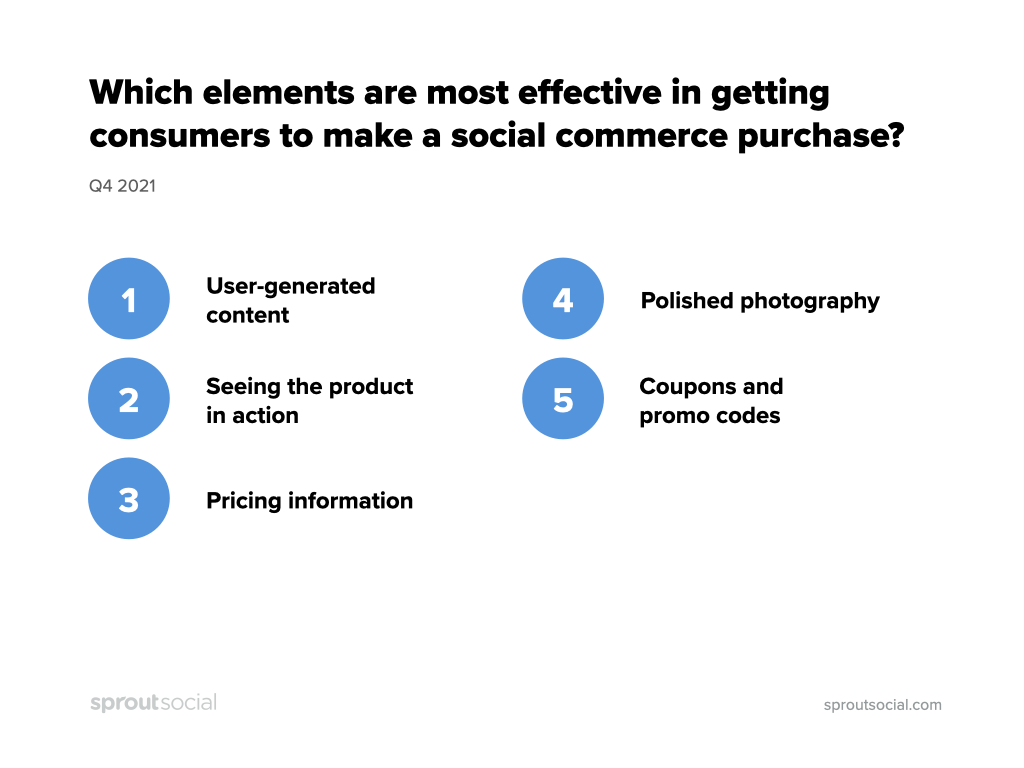
Now let’s look at the most crucial aspect of social commerce: Data and Analytics.
6. Data and Analytics for Social Commerce:
Ever wondered how businesses seem to know exactly what you’re looking for?
It’s not magic; it’s the power of data and analytics in the world of social commerce.
Let’s explore how businesses are leveraging these tools to refine their strategies and create a shopping experience tailored just for you.
6.1. Understanding Customer Behavior:
Data is like a treasure trove of insights into customer behavior.
Businesses are using analytics to understand what you click on, what you ignore, and what makes you click “buy.”
It’s not about spying; it’s about creating a shopping experience that resonates with your preferences.
6.2. Conversion Tracking:
Ever clicked on an ad and wondered if it led to actual sales?
Conversion tracking is the answer.
Businesses use this tool to measure the effectiveness of their social commerce strategies. It’s not just about clicks; it’s about turning those clicks into conversions.
6.3. Insights from Social Platforms:
Social media platforms offer businesses a goldmine of insights.
From the demographics of their audience to the most engaging posts, businesses are using these analytics to fine-tune their content and strategies.
6.4. Customer Journey Mapping:
Ever notice how your journey from discovery to purchase feels seamless?
That’s the result of businesses mapping the customer journey using analytics.
They track every interaction, from the first click to the final checkout, ensuring each step is optimized for a delightful experience.
6.5. Predictive Analytics:
Imagine businesses predicting what you might want to buy next. It’s not fortune-telling; it’s predictive analytics.
By analyzing your past behavior and preferences, businesses can anticipate your needs and offer recommendations that feel almost telepathic.
Feedback Loops and Continuous Improvement:
Data and analytics create a feedback loop for businesses.
They don’t just analyze past performance; they use insights to continuously improve. It’s a dynamic process of refining strategies based on what works and what doesn’t.
Businesses that embrace this iterative approach often see sustained success.
Related Posts
The Impact of Social Media on Blog Engagement
Crafting Your Digital Identity: A Comprehensive Guide to Creating a Personal Brand for Your Blog
Video Marketing in the Digital Age: Creating Engaging Content
Conclusion
With this, we come to the end of our journey of exploring social commerce, and let’s recap what we learned.
In a world where every click, every post, and every interaction holds the potential to shape the shopping experiences of millions, social commerce is not just a transaction; it’s a conversation.
It’s about creating a digital space where businesses don’t just sell products; they build connections, tell stories, and turn likes into lasting relationships.
As you continue your exploration of the social commerce universe, we encourage you to embrace the dynamism, stay informed about emerging trends, and remain open to the exciting possibilities that await.

